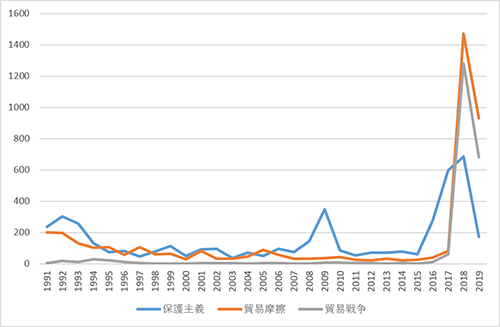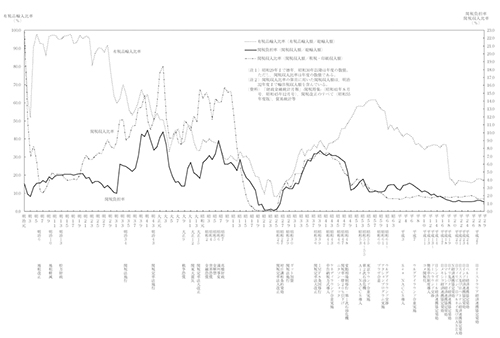On the State of International Trade in the Current Age
Yoshimasa Komoriya
Associate Professor, Faculty of Economics, Chuo University
Area of Specialization: International trade, international economic policies
The Current Situation Surrounding International Trade
The situation surrounding international trade has been in turmoil since the inauguration of US President Donald Trump in January 2017. Starting with withdrawing from the Trans-Pacific Partnership (TPP) immediately after his inauguration, in March 2018, the administration imposed tariffs on steel and aluminum. The tariffs imposed on China in July the same year have been increased for the third time. Going into 2019, the administration banned imports of Huawei products over security concerns, in addition to raising the tariff rate for the fourth time on Chinese products, increasing tensions between the two countries. To escalate matters, the countries that were targeted by the US trade policies responded immediately, with the EU and China raising tariffs on American products as a countermeasure (retaliatory tariffs).
Meanwhile, corporations are not merely standing by in the midst of these exchanges between governments. Seeing the results of the retaliatory tariffs imposed by the EU and China as a response to the punitive US tariffs, US-based Harley-Davidson shifted their base for China exports from the US to Thailand, and is also considering shifting its production of vehicles for the European market to manufacturing bases within Europe (Nihon Keizai Shimbun, April 24, 2019, evening edition). In a separate case, after the US implemented punitive tariffs against China, Chinese exports to the US declined, while exports to Vietnam, Taiwan, and Mexico have increased. It has been reported that exports from those countries to the US have also increased (Nihon Keizai Shimbun, June 1, 2019, morning edition). In short, companies are circumventing high tariffs through foreign direct investments (FDI) (a method referred to as "tariff-jumping FDI") and through roundabout trade.
As I am someone who studies, researches and teaches international economics, to me this situation is in some ways fascinating, but also frustrating. This is because the contents of our students' textbooks are happening repeatedly in front of our very eyes.
What We Learn as the Basics of International Economics
It has been about 20 years since I first started learning about international economics as an undergraduate. During that time, great advancements were made in the research of international trade. The biggest advancement was the emergence of a "new" new trade theory, which is a theory based on a paper published by Marc Melitz, a professor at Harvard University, in 2003. This allowed us to theoretically explain the differences in overseas developments like exports and FDI between companies in the same industry. Another advancement was the development of empirical studies using microdata. Empirical studies have developed in other fields as well, including advancements in data maintenance, improvement in computing power, and progress in analytical methods. However, the advancements in international trade research were especially remarkable in that various factors were brought to light with the emergence of the "new" new trade theory that I mentioned earlier.
This "new" new trade theory is already in our students' textbooks today, but when I was a student, and even now as a teacher, when studying the basics of international trade theory, the subjects of gains from trade resulting from exchange advantages and benefits of specialization and the harmful effects of trade policies are mentioned without exception. Trade enables countries to eliminate the need to produce every type of goods that are consumed within that country. This allows countries to transition industrial resources from inefficient industries to efficient industries, which in turn results in a more prosperous consumer population. This is what is referred to as the benefit of specialization. The movement toward free trade expands these benefits, and when a country moves away from free trade, these benefits are reduced.
Most textbooks also explain that if a large country that is capable of impacting global commodity prices imposes import duties, it can improve its economic welfare. However, the textbooks also never fail to mention that such duties are beggar-thy-neighbor policies that negatively impact other countries. These policies lead to retaliation from partner countries, resulting in a cycle of increased tariffs, with each side falling into a situation of imposing high import taxes on each other. I never thought that I would be teaching these concepts while seeing them actually happen in the real world.
How to Consider the Current Situation
In order to understand that the current situation is not normal, I decided to compile how often the terms "protectionism," "trade friction," and "trade war" are mentioned in articles in the Nihon Keizai Shimbun morning edition newspaper. Figure 1 shows the results of the aggregated number of hits when I looked up each of the terms in the 29 years between 1991 to 2019 (up to July 10) using Nikkei Telecom.
During the early 1990s, both the terms "protectionism" (blue line) and "trade friction" (orange line) are mentioned relatively frequently, but the mentions of protectionism can be explained by the stagnation of the world economy following the end of the Cold War, and the mentions of trade friction can be explained by the Japan-US trade friction. Protectionism is mentioned frequently in 2009 when countries pursued protectionist policies following the bankruptcy of Lehman Brothers in the previous year. An article published on November 22, 2009 reads, "According to an investigation by the World Trade Organization (WTO), after October 2008, when the financial and economic crises intensified, 52 countries and regions implemented a total of 290 protective trade measures." This was due to the increase in temporary protectionism following economic shocks, so during this time, the term "trade friction" is rarely mentioned.
Even during the collapse of Lehman Brothers, the number of search hits for "protectionism" was 145 in 2008 and 349 in 2009, but in recent years, the numbers jumped from 61 search hits in 2015 to 278 search hits in 2016, then to 595 search hits in 2017 and 685 search hits in 2018. Furthermore, in contrast with the period during the Lehman Brothers collapse, the recent movement toward protectionism is also causing trade friction. As proof of this, the number of search hits for the term "trade friction" jumped from 37 hits in 2016 to 82 hits in 2017, with an explosive increase to 1,470 hits in 2018, surpassing mentions of protectionism. In addition to that, the use of the term "trade war" (gray line), which was very rarely used in the past, has increased dramatically. This alone shows how different the current situation is, at least compared to the past 30 years or so, and how much of a serious problem this is.

Figure 1: The rise in concern according to newspaper articles (in the Nihon Keizai Shimbun morning edition)
What We Need to Consider Now
In the midst of this situation where issues like protectionism and trade friction are becoming major topics of concern, you may expect students to have a heightened interest in international trade and the international economy. However, it seems this is unfortunately not the case. It may be that outside of the university campus, there is a clear divide between those who are interested and those who are not. On that note, I want to mention two more points to end this article.
The first is the topic of how we should pursue the benefits of trade. Explanations of the benefits of trade are accompanied by explanations of how free trade or the implementation of certain trade policies have vastly different impacts depending on whether you are a consumer, a manufacturer, a laborer, or an owner of capital stock. To have sufficient concern for the harmful impact on a certain group and to only emphasize the interest of a certain group are falsely similar concerns. It is necessary to spark the interest of a large number of people and have debates on how to pursue the benefits of trade as one country.
The second point is the movement toward free trade and the stability it brings. Figure 2 is taken directly from the 795th issue of the Ministry of Finance Statistics Monthly, from a section in page 104 titled "(Reference) 2. Tariff Revisions and the Transition of the Tariff Burden Rate." I find this graph to be very useful and I use it in my lectures. This figure shows the import rates of taxable goods (solid line) and the tariff burden rate (dashed line) since 1868. The lines are too finely drawn to see the details, but the overall trends can be understood. Although there were localized vertical movements following the Second World War, Japan has steadily been on the path toward free trade. This pattern is the same in many other countries. The world we live in today is one that has been constructed by the work of many people. However, there is no evidence that this should allow us to be optimistic in viewing this as a stable condition.

Figure 2: Tariff revisions and the transition of the tariff burden rate (reprinted from Issue 795 of the Ministry of Finance Statistics Monthly)
- Yoshimasa Komoriya
Associate Professor, Faculty of Economics, Chuo University
Area of Specialization: International trade, international economic policies - Yoshimasa Komoriya was born in Yokohama, Kanagawa Prefecture in 1976. He graduated from the Yokohama National University Department of Economics Undergraduate Program in 2000.
He completed his master's course at the Hitotsubashi University Graduate School of Economics, and finished his doctoral course without a degree after completion of required course credits at the same university. He is a Doctor of Economics (Hitotsubashi University).
He became an assistant professor at the Faculty of Economics, Chuo University in 2009, and assumed his current post in 2013. His expertise is in international trade theory. His focus is on the theoretical analysis of the relationship that trade policies have with foreign direct investments and the overseas development of companies. He is also researching the overseas development of companies in relation to international taxation.
Major publications include "Stay or Leave? Choice of Plant Location with Cost Heterogeneity" (Japanese Economic Review, 2010) (co-authored with Jota Ishikawa), and Kinyu Kiki-go no Sekai Keizai no Kadai (The Challenges Facing the Global Economy Following Financial Crises) (Chuo University Press, 2015) (joint-editorship with Seiichi Nakajo).








